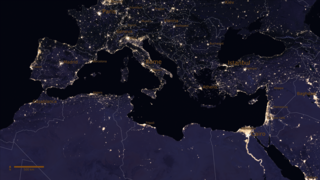Earth
ID: 30512
Phytoplankton are microscopic organisms that live in watery environments, forming the foundation of the aquatic and marine food webs. Phytoplankton populations can grow explosively creating bright green and blue marble swirls, or blooms, near the surface. This visualization shows global daily averages of suspended particulate inorganic carbon (PIC, known as calcium carbonate or limestone) from July 4, 2002 to May 26, 2014, made with data from Aqua/MODIS. One can see shades of bright turquoise circling the Southern Ocean, a unique and consistent feature characterized by the presence of elevated PIC concentrations near the Sub-Tropical, Sub-Antarctic, and Polar Fronts. Referred to as the "Great Calcite Belt," high PIC concentrations result from large numbers of highly reflective microscopic PIC plates called “coccoliths,” released from calcifying coccolithophores. Such regions of elevated reflectance have been observed each year during austral summer with minor variations from year to year. Many sectors of the Southern Ocean are generally characterized by low concentrations of potentially growth limiting iron (Fe) concentrations. Studies suggest, however, that coccolithophores are well adapted to growth under low ambient iron conditions.

Bright Waters of the Southern Ocean

For More Information
Credits
Marit Jentoft-Nilsen (Global Science and Technology, Inc.): Lead Animator
Marit Jentoft-Nilsen (Global Science and Technology, Inc.): Producer
William M. Balch (Bigelow Laboratory for Ocean Sciences): Scientist
Heather Hanson (GST): Writer
Marit Jentoft-Nilsen (Global Science and Technology, Inc.): Producer
William M. Balch (Bigelow Laboratory for Ocean Sciences): Scientist
Heather Hanson (GST): Writer
Please give credit for this item to:
NASA's Goddard Space Flight Center
NASA's Goddard Space Flight Center
Acknowledgements: Shipboard verification that the elevated reflectance in the imagery was produced by coccolithophores was performed by the Balch laboratory group at the Bigelow Laboratory for Ocean Sciences (E. Boothbay, ME) operating on the R/V Melville and R/V Revelle, operated by Scripps Inst. of Oceanography (La Jolla, CA). N. Kuring (Ocean Color Group, NASA Goddard) provided the real-time PIC imagery to the research vessels at sea in order to guide the coccolithophore sampling.
This visualization was created from Aqua MODIS Particulate Inorganic Carbon (PIC) daily 9km hdf data files from NASA's Oceancolor website.
Short URL to share this page:
https://svs.gsfc.nasa.gov/30512
Data Used:
Note: While we identify the data sets used in these visualizations, we do not store any further details nor the data sets themselves on our site.
Keywords:
SVS >> HDTV
SVS >> Hyperwall
NASA Science >> Earth
SVS >> Presentation
SVS >> Particulate Inorganic Carbon
https://svs.gsfc.nasa.gov/30512
Data Used:
Aqua/MODIS
Keywords:
SVS >> HDTV
SVS >> Hyperwall
NASA Science >> Earth
SVS >> Presentation
SVS >> Particulate Inorganic Carbon











